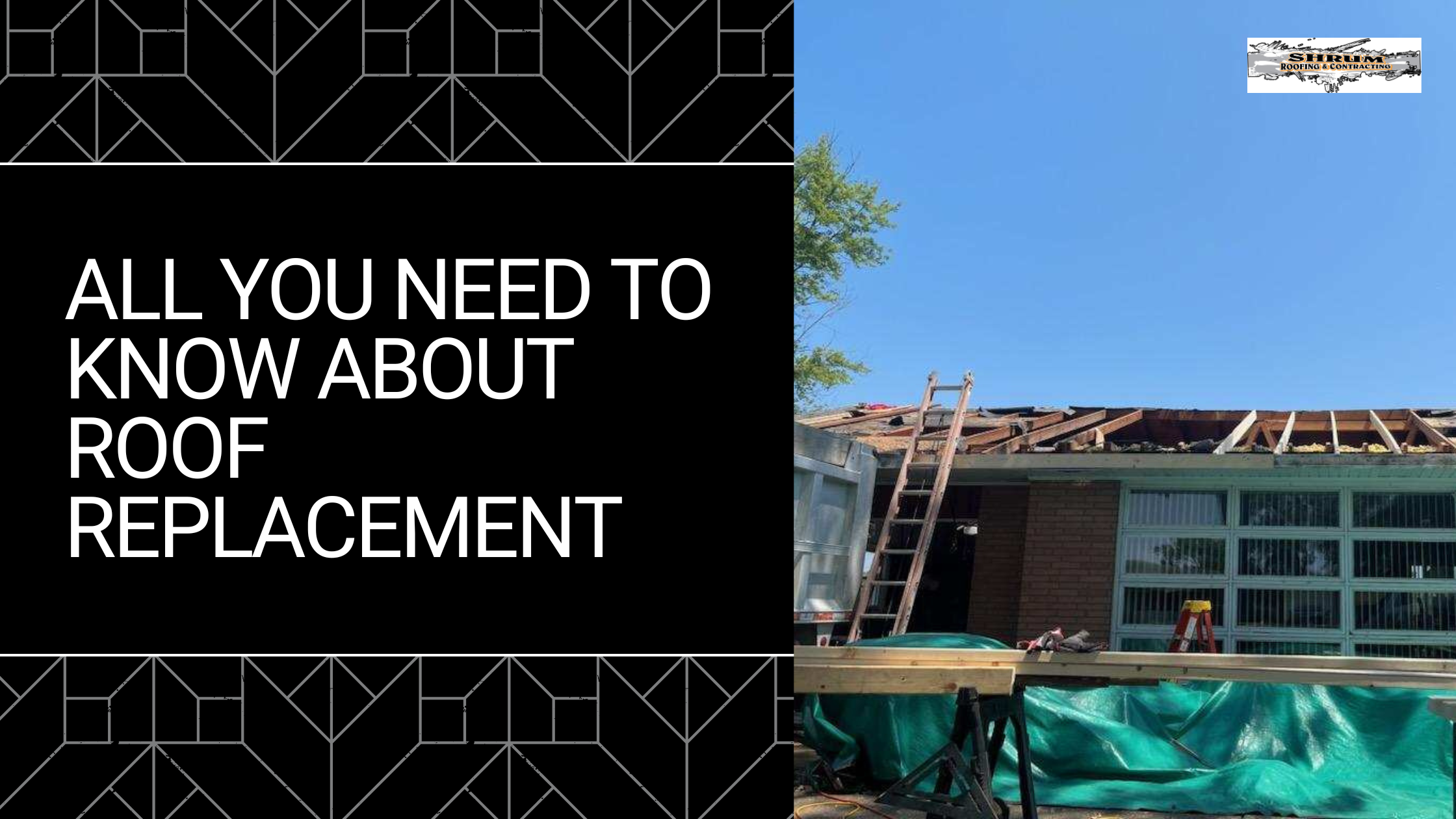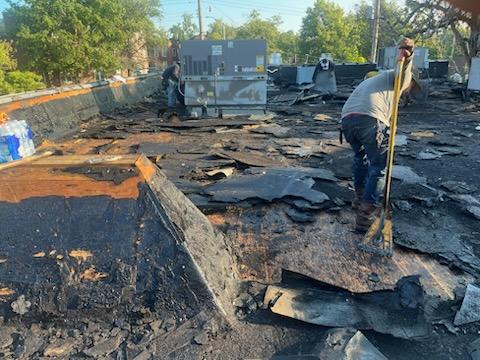All You Need to Know about Roof Replacement

- Look for signs like age, curling/missing shingles, granules in gutters, moss growth, or a sagging roof deck to determine if a roof replacement is needed.
- The replacement process often involves initial consultation, proposal, permitting, old roof tear-off, decking/underlayment installation, new material installation, and a final inspection with cleanup.
- Replacing your roof offers less maintenance, increased home value, improved energy efficiency, and access to new technology.
Your roof protects your family, belongings, and the structure of your home, but it doesn’t last forever. The constant exposure to sun, rain, snow, wind, and temperature changes takes its toll over time. If you’ve noticed signs of wear, it might be time to start thinking about a replacement.
Here’s a guide to help you through everything you need to know about roof replacement.
How to Know When It’s Time for a Roof Replacement?
Replacing your roof is a big decision, but there are often a lot of warning signs. Here are some of the most common ones that you can look out for:
- Age: Most asphalt shingle roofs, common in residential homes, typically last between 20 to 25 years. If your roof is approaching or has exceeded this age, it’s worth having it professionally inspected. This is because materials degrade over time due to constant exposure to UV rays, temperature fluctuations, and weather events. Knowing your roof’s age is a crucial starting point.
- Curling or Cupping: Check if your shingles are curling at the edges or sinking in the center. Both are signs of significant wear and tear, often due to aging and thermal shock. Curled or cupped shingles are more prone to cracking and breaking, allowing water to infiltrate.
- Missing Shingles: One or two missing shingles after a fierce storm might be repairable. However, you should consider a replacement if you notice widespread missing or cracked shingles across different sections of the roof.
- Granules in Your Gutters: Those gritty, sand-like particles accumulating in your gutters are the protective granules from your asphalt shingles. These granules shield the asphalt from the sun’s harsh UV rays. Once they start shedding extensively, the asphalt layer beneath is exposed, accelerating its deterioration.
- Moss Growth: While dark streaks from algae or moss can sometimes be cleaned, extensive growth can indicate that your roof retains moisture. Moss can also lift shingles and let water seep underneath, leading to wood rot and leaks.
- Sagging Roof Deck: Check for any visible sagging or drooping in the roof deck between the rafters. This could indicate a serious structural issue, possibly from water damage or an overloaded roof.
The Roof Replacement Process
Roofing projects are generally diverse, involving different factors. However, most processes would follow a set of similar steps:
Step 1: Initial Consultation and Inspection
The journey begins with a thorough inspection of your existing roof. The roofing professionals assess its current condition, identify problem areas, and discuss your needs, preferences, and budget. This is also where they help you choose the best fit for your home and local climate.
Step 2: Detailed Proposal and Contract
Based on the inspection and your choices, the roofer will provide a detailed proposal outlining the scope of work, chosen materials, estimated timeline, and total cost. Once you’re satisfied, they will sign a comprehensive contract that protects both parties and ensures clarity.
Step 3: Permitting and Planning
Before any work begins, the roofers should handle all necessary permits and adhere to local building codes in Waterloo and Columbia, IL. They will also meticulously plan the logistics, including material delivery, debris disposal, and crew scheduling, to ensure the least disruption.
The team should take great care to protect your home and landscaping. Tarps should be laid over shrubs, flowerbeds, and driveways to catch debris and safeguard your property during the removal and installation phases.
Step 4: Old Roof Tear-Off
This is where the transformation truly begins. The existing roofing materials, including old shingles, felt paper, and any damaged decking, are carefully and efficiently removed. This step allows the roofer to inspect the underlying roof deck for any rot, damage, or structural issues that need addressing. Any compromised wood is repaired or replaced at this stage.
Step 5: Decking and Underlayment Installation
With a clean slate, the robust foundation for your new roof is laid. If required, new plywood decking is installed to ensure a smooth, stable surface. Next, a high-quality underlayment is rolled out over the entire roof deck. This acts as an additional barrier against moisture during heavy rains or ice dams.
Step 6: Flashing and Ventilation
The roofing experts meticulously install or replace flashing around chimneys, skylights, vents, and in valleys, which is critical for preventing leaks. They also install appropriate attic ventilation systems (ridge vents, soffit vents, etc.) to ensure proper airflow, which helps regulate attic temperature and improves your home’s energy efficiency.
Step 7: Material Installation
This is the most visible part of the process. Starting from the bottom edge of the roof, the new shingles, metal panels, or tiles are carefully installed layer by layer in an overlapping pattern. It’s important to adhere to manufacturer specifications and industry best practices for precise and durable installation.
Step 8: Final Inspection and Cleanup
Once the new roofing material is fully installed, project managers conduct a thorough final inspection to ensure every detail meets rigorous quality standards and local codes. The team then undertakes a meticulous cleanup, ensuring no debris, nails, or materials are left behind.
Benefits of Replacing Your Roof
A roof replacement can offer a range of advantages to your home. Let’s look at some of the major benefits:
Less Maintenance
Older roofs would’ve been subjected to years of wear and tear, meaning they will likely require more frequent and costly repairs. A new roof, on the other hand, is built to last. Modern roofing materials and installation techniques significantly reduce the need for constant patching and maintenance, freeing up your time and saving you money in the long run.
Increased Home Value
In real estate, first impressions are everything, and a pristine roof speaks volumes about the condition of your home. It dramatically boosts your home’s curb appeal, making it more attractive to potential buyers and often commanding a higher selling price.
Improved Energy Efficiency
Gaps, cracks, and inefficient materials in old roofs can allow heat to escape in winter and seep in during summer. This forces your HVAC system to work overtime. A new roof, especially when paired with proper underlayment and a well-designed attic ventilation system, creates a more effective thermal envelope. This helps maintain consistent indoor temperatures, reducing the workload on your heating and cooling systems. This translates directly into lower utility bills.
Access to New Technology
A roof replacement is an opportunity to upgrade to the latest materials and design. You could opt for
- Impact-resistant shingles designed to withstand hail
- Cool roof materials that reflect solar heat and reduce cooling costs
- Highly durable synthetic options that mimic traditional materials like slate or wood shake
This versatility lets you select a roof that can be tailored to your specific needs and environmental conditions.

Factors to Consider During the Process
The replacement process involves several key decisions that can impact the outcome, cost, and longevity of your new roof. Taking the time to consider the following factors will help you streamline your project:
- Roofing Material Options: Your choice of material will affect your roof’s durability and appearance. Asphalt shingles are the most common due to their affordability and ease of installation. Metal roofs are long-lasting and weather-resistant. Think about your budget, climate, and how long you plan to stay in your home before choosing.
- Cost and Financing: Roof replacement costs can vary based on the size of your roof, the material you choose, and labor rates. Always get a written estimate. Some contractors also offer financing options, which can help break the total into more manageable monthly payments.
- Roof Slope and Design Complexity: Roofs with steep slopes or complex architecture like dormers, skylights, or multiple valleys can be more challenging to replace. This can increase the time, labor, and cost involved. Be sure your contractor factors this into their quote.
- Timing and Weather: Roofing is best done in mild, dry weather—typically spring through fall. Try to avoid scheduling during extreme heat, cold snaps, or wet seasons, as these can delay work or affect material performance. If an emergency repair is needed, professionals can adapt with the right tools and planning.
- Warranties: Always ask about warranties. A new roof should come with a manufacturer’s warranty for materials and a workmanship warranty from the installer. Read the fine print—know what’s covered, what’s not, and for how long. A good warranty adds peace of mind and long-term value.
- Impact on Daily Life: Roof replacement is noisy and disruptive. Kids, pets, and home-based workers might be affected during installation days. Most projects last a few days, depending on size and complexity, so plan ahead to minimize stress.
The Importance of Professional Roof Inspections
Professional roofers possess years of experience and specialized training. They have a keen eye for subtle indicators of damage or wear that an untrained homeowner would easily overlook. They understand the nuances of how different roofing materials age, how various weather patterns affect specific components, and where common problems typically manifest.
You should also note that climbing onto an old roof is inherently dangerous. Professionals are trained in stringent safety protocols and come equipped with the necessary safety gear, including harnesses, fall protection, and appropriate ladders. They know how to navigate steep pitches, unstable surfaces, and hazardous areas without putting themselves, your family, or your property at risk.
If your roof has suffered damage from a storm, hail, or high winds, a professional inspection provides credible and objective documentation that is valuable for your insurance claim. A detailed report from a reputable roofing company, often accompanied by photographs, clearly articulates the extent and cause of the damage, along with the recommended repairs or full replacement.
Why Choose Shrum Roofing & Construction?
We at Shrum Roofing & Construction are an integral part of St. Clair, Monroe County, and the surrounding areas. Our deep roots here mean we intimately understand the unique challenges posed by local weather patterns, from intense summer storms to harsh winter conditions.
From the moment we select our materials to the final nail driven, excellence is our standard. We partner only with reputable manufacturers to source the highest-grade roofing materials available, ensuring superior durability and performance. We adhere strictly to manufacturer specifications and industry best practices, never cutting corners.
We provide straightforward, unbiased assessments of your roof’s condition, always explaining what we find in plain language. Our proposals are detailed, itemized, and free of hidden fees, ensuring you understand exactly what you’re paying for. We encourage questions and are dedicated to providing clear, comprehensive answers.
If you’re seeing signs of wear, roof replacement might be the right move. Our team at Shrum Roofing & Construction can make the process smooth, simple, and worry-free. Call us at (618) 977-3425 or contact us online to schedule an appointment!
